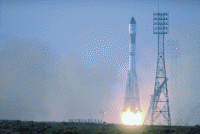Lift-off from Kazakhstan
11 August 2000
This is the final entry in the Cluster II Launch Campaign journal series, which ran from April 2000 until shortly after the launch of the second pair of Cluster spacecraft in August 2000. The journal covered the main activities during this period: from the shipment of the four spacecraft to the launch site in Kazakhstan, through the final integration of the spacecraft with the launchers, to the launches.Cluster II was launched from Baikonur Cosmodrome in Kazakhstan on 16 July 2000 and 9 August 2000. The four satellites were put into orbit, in pairs, by two Soyuz rockets provided by the Russian-French Starsem company. Starsem has four shareholders - Aerospatiale, Arianespace, the Russian Space Agency and TsSKB Samara, the manufacturer of the Soyuz vehicle.
The Soyuz is a more powerful version of the rockets that launched the world's first satellite in 1957 (Sputnik) and the first spaceman in 1961 (Yuri Gagarin). Between them the various versions of the booster have completed more than 1600 successful launches. Although the Soyuz first flew in 1963, it is still used to orbit both manned and unmanned spacecraft. Its future operations will include delivering crews and cargo to the International Space Station. Liftoff of a Soyuz launcher from Baikonur.
 |
|
Liftoff of a Soyuz launcher from Baikonur |
When the Cluster II mission was approved by ESA's Science Programme Committee in April 1997, it was decided that a launch on a European Ariane rocket would be too expensive. The only feasible solution, bearing in mind the project's strict financial constraints, was to launch the spacecraft using two Soyuz launch vehicles, each equipped with a newly designed Fregat upper stage. The contract for launch of the Cluster II satellites was signed on 24 July 1998 at ESA Headquarters in Paris.
The first pair of Cluster II satellites lifted off on 16 July 2000, and were followed by the second pair one month later. This gap allowed fewer people to be used for mission control in the European Space Operations Centre (ESOC) in Darmstadt (Germany).
